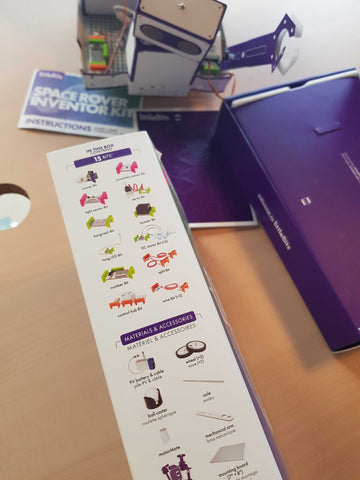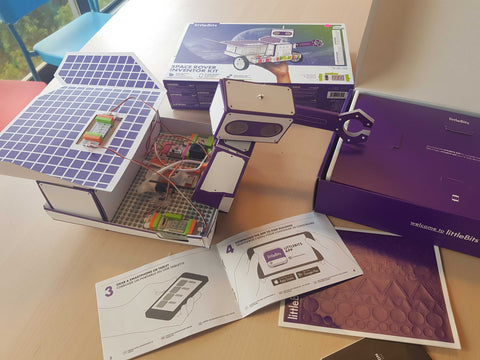littleBits—now owned by Sphero—is a hands-on system of snappable electronic building blocks that allow students of all ages to create with technology. They're great for teaching kids about electronics without soldering, and are also fun for adult makers who want a playful solder-free experience. In this piece, I'll explore the Space Rover Inventor Kit, a successor to the Space Kit from when littleBits first started out.
littleBits Space Rover Inventor Kit
The littleBits Space Rover Inventor Kit was inspired by the National Aeronautics and Space Administration (NASA). As with other kits, different bits, like the power, servo, and wire bits, are listed on the side of the product sleeve, providing a list of parts available for users to reference.

Upon opening the box, I was greeted with an assortment of different bits (components), colour coded to their respective functions in a circuit—blue for power, green for output, orange for wire, and pink for input. They're modular, allowing the bits to be easily combined and reconfigured to create brand new inventions. The bits can be effortlessly snapped together with magnets, providing a simple and intuitive experience, prevents short-circuiting and removes the need for soldering. There are no sharp edges, and the blobs of solder on the bits are smooth to the finger, making it safe for children to touch and handle. The recommended age for littleBits is ages eight and up.
Making
The base of the Space Rover's chassis is a mounting board, where the different bits snap onto, and a cutout cardboard template. The mounting board is quite spacious (17 cm by 18 cm) that you can snap additional bits onto it, say from other littleBits Kits.

One possible downside of the Inventor themed kits is the requirement of a mobile device or a tablet to access the instructions, creating a barrier for parents/teachers and making screen time a must. The littleBits app is available on both iOS and Android; for the younger kids, I recommend having an adult around to help set up the app, as it requires an account creation after downloading.
The video tutorials included in the app are useful, detailed and demonstrate step-by-step instructions, from how to snap/connect the bits, to folding each section of the cardboard template into place. (Some origami skill required!) The video tutorials also cover the purpose of each bit, why they have different colours, and how to construct a circuit properly.
One thing to note, though, is that the provided cardboard cutout can be a bit flimsy, and will naturally wear out over time. That might make it hard to attach to the mounting board. A quick glance at littleBits community sites can give you ideas on how other makers have adapted and redesigned the cover (cardboard cutout) with simple crafting materials, adding a touch of creativity and lifespan to the kit.
I thought the app's user interface could have been a bit more forgiving. For instance, having to create an account felt a bit unnecessary, and I would have appreciated a PDF copy of the instructions. If the app could also provide more context, such as information on current NASA projects or rover related projects, that would certainly help add more current-day relevance to the Space Rover Kit for kids!
Control
Operating the littleBits Space Rover was simple enough, especially if you have played with any remote control toys.
Start by connecting your phone or tablet to the control hub part of the circuit (Bluetooth required). The app features on-screen joysticks and buttons, somewhat similar to a physical remote control, that control the Space Rover's mechanical arm and head, as well as drive the rover left, right, forward or backwards.
As I progressed through the app, I encountered mini-games and challenges designed to test out our new creation. You can go through these, or just roll your rover around happily—how far you want to develop the rover is entirely up to you. I really enjoyed the nifty little feature where the rover can play sounds or record sounds while being driven.
Conclusion
Overall, the kit is excellent for children, especially if they are interested in science, technology or space. At S$319, though, parents may want to make sure your children are really into space and tinkering—otherwise, if you are keen on the idea of swappable circuits, the littleBits line has different theme kits at various price points that might serve better as a first STEAM (Science, Technology, Engineering, Arts, and Math) toy.
Teaching kids the basics never goes wrong, and the Space Rover Inventor Kit is suitable for a parent-child bonding experience coupled with the community site to get inspired and make beyond what is in the box. All in all, despite the price and minor quibbles, I would definitely recommend this kit to parents who want to nurture STEAM interest in kids.
—
This post was written by Iskandar, a Business & Engineering intern from Republic Polytechnic, who's really into digital making.

